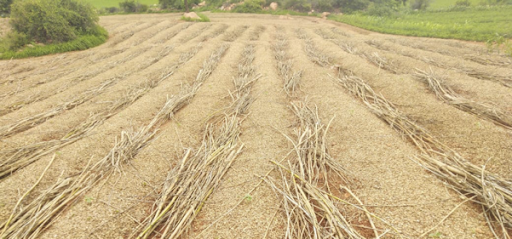Bandari Pushpavathi, and her husband, relied on expensive chemical-inputs, to cultivate groundnut and red gram over .6 acres of land in the drought-prone district of Anantapuram in Andhra Pradesh (AP). While several Indian regions now face erratic monsoon, the Anantapuram district experiences one of the country’s lowest rainfall with an annual rainfall of around 500 mm. Almost 90 percent of its agriculture is rainfed, and the water retention capacity of its Red Soil is extremely low. Farming for Pushpavathi and her family was a loss-making profession, primarily due to heavy dependence on rainfall.
“India ranks first in rain-fed agriculture, both in area and value of produce. It occupies 67 per cent net sown area, contributing 44 percent of food grains. Despite supporting 40 percent of the population, rainfed areas have been facing several adversities – deteriorating natural resource quality; biophysical and socio-economic constraints; crop failure; erratic rainfall; non-remunerative prices.”
Things changed for Pushpavathi in the year 2018. As part of AP’s Natural Farming (APCMNF) program, she was introduced to an innovative solution in this desertified district – Pre-Monsoon Dry Sowing (PMDS).
“Natural Farming – a form of regenerative agriculture – is an alternative to chemical fertilizer and pesticides intensive agriculture. It exemplifies agroecological principles where the main emphasis is on enhancing soil health by managing soil biological activities and organic matter. It allows for a wide range of agroecological practices, including mulching, crop rotations, agroforestry, conservation agriculture, livestock integration.”

Simply put, the PMDS technique harnesses water vapour from the air and provides moisture to the soil. It is tilling, sowing, and tending the land, where the farmers grow crops in the non-farming season. Farmers sow between 12 and 15 different seeds in dry soil before the advent of the monsoon in April. There are a few particular protocols for land preparation and sowing to ensure seed germination and crop growth. The seeds are coated with a microbial inoculum, and a concoction of cow dung, cow urine, jaggery, pulse flour, water, and soil is applied to the land to multiply soil microbes. The use of mulch is advocated for higher soil humus production, further enhancing the water vapour condensation on the soil surface and its water retention capacity.
“Experiments in PMDS have led to the innovation of 365 Day Green Cover, to ensure harnessing of a portion of the ‘50,000 ppm water in the air’ for plant growth. Natural farming through PMDS enables soil aggregation through fungal hyphae, bacteria, and root exudates coming together and making the soil more porous and permeable.”

Even though the science behind the process is being studied, it is already considered a breakthrough in the agricultural scientific community. “PMDS has global implications. We can support the assured increased income of the farmers and nutritive gains through diversified crop intensity, specifically in India’s semi-arid and rainfed areas. In the medium to long term. PMDS techniques can potentially reverse desertification, land degradation and arrest soil erosion in high-rainfall hilly regions in the long term. This has a significant climate change mitigation impact through accelerated carbon sequestration.”, says Vijay Kumar Thallam, natural farming pioneer and head of the APCMNF program.
Pushpavathi’s now grows more than 18 different crops – leafy vegetables, eggplants, tomatoes, carrot, radish, castor, cluster beans, field beans, cowpea, red gram, green gram, millets, and groundnut on 0.6 acres of land. She also uses groundnut husks and sesbania sticks to reduce moisture evaporation and enhance the water-vapour air movement in the soil.

When asked if her workload has increased in preparing these natural inputs, Pushapavati replies, “ In the beginning, it was very hard – carrying dung and cow urine to my field, remembering how to mix things – but over time, I have learned well, and it has made my life so much better. I am very proud of my field.”

In 2021, Pushpavathi earned a total income of INR 45,000 (USD 600) in six months from the 0.6 acres of PMDS plot. She expects annual revenue of INR 70,000 (USD 930) – a 3-5 times higher net income than her previous income and the average farmers in that district. Besides the monetary gains, Pushpavathi also observed the plants being more resilient in her fields, the leaves greener and soil darker. “I notice some fine hairs on the leaves. I believe because of these hairs; plants can endure the hot weather of Anantapuram; they glow and stay fresh through the day while others’ plants all get dry”, she said, while attributing these changes to mulching and the PMDS methods. Her plans include extending the PMDS practice to 1 acre and integrate it with a tree-based, multi-layer cropping model.

Agricultural intensification in India has led to considerable adverse environmental impacts, including soil degradation, GHG emissions, eutrophication of water bodies, and much biodiversity loss. Climate change poses another serious threat to Indian agriculture, mainly rainfed and fundamentally dependent on climatic stability.
“Almost 96.4 million hectares, 30 percent of the country’s total geographic area, is undergoing significant land degradation/desertification.”
In 2020-21, the APCMNF program successfully brought 35,000 farmers to adopt PMDS, covering almost 23,000 acres of land across the state. While the research of its different aspects is still in progress, PMDS holds the promise to allay the agricultural woes of millions of small and marginal farmers in India by ensuring additional incomes and improving soil porosity.

Pushpavathi is an inspiration to many in her village. She is now one of the farmer trainers who help and motivate other farmers to follow PMDS. Many farmers visit her field, inspired by her determination, hard work, and successful results. Despite not having a water source (only rainfall), she is motivated to increase her income and area under natural farming. Pushpavathi’s field can be seen from far away, one of the greenest in her village.



